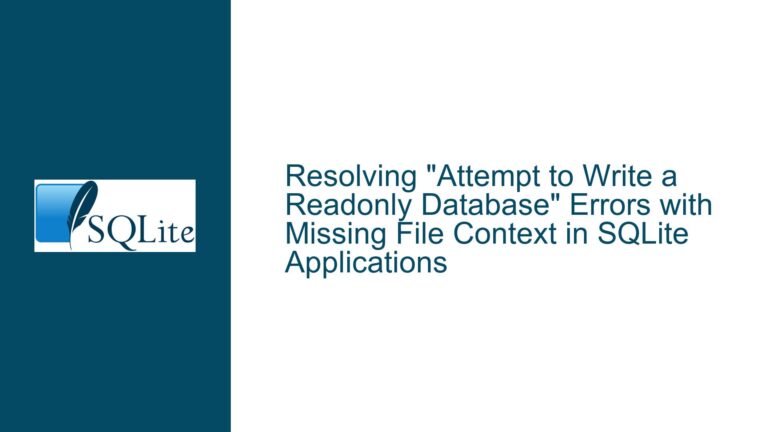Managing Concurrent SQLite Access: Connection Pooling vs. Message Passing Architectures
Concurrency Challenges in SQLite: Pooling vs. Message Passing Trade-offs
SQLite’s architecture enforces strict serialization rules for write operations, requiring applications to carefully manage concurrent access. Two dominant paradigms emerge for handling asynchronous operations: connection pooling and message passing. Both aim to coordinate access to a single database file while balancing performance, scalability, and correctness.
The Core Dilemma
In connection pooling, multiple pre-initialized database connections are maintained in a shared pool. Threads or asynchronous tasks borrow connections temporarily, execute SQL operations, and return them to the pool. This reduces the overhead of repeatedly opening/closing connections but introduces contention for shared locks.
Message passing centralizes database access through dedicated worker threads. Clients submit SQL commands via queues or channels, and the workers execute them sequentially. This avoids lock contention by design but complicates transactional workflows and response synchronization.
Performance vs. Correctness
Connection pooling excels in read-heavy workloads by allowing parallel read operations (assuming WAL mode is enabled). However, write-heavy scenarios risk frequent SQLITE_BUSY errors due to lock escalation. Message passing eliminates lock contention by serializing writes but introduces latency for read operations that must wait in line behind writes.
The forum discussion highlights critical edge cases:
- Multi-statement transactions in message passing architectures risk interleaving if not properly isolated.
- Green threads (e.g., Go’s goroutines) exacerbate connection starvation in pooling models due to their lightweight, high-concurrency nature.
- Connection sterilization (resetting connection state) is non-trivial and error-prone when reusing pooled connections.
Root Causes of Lock Contention and Transaction Serialization Failures
Lock Escalation in SQLite
SQLite uses a progressive locking mechanism:
- UNLOCKED → SHARED (read access).
- SHARED → RESERVED (prepare to write).
- RESERVED → EXCLUSIVE (commit writes).
Connection pooling struggles because pooled connections may hold SHARED locks indefinitely, blocking writers. Message passing avoids this by funneling all writes through a single thread, but misconfigured channels can still interleave transactions.
Connection Pooling Pitfalls
- Stale Locks: A connection returned to the pool may retain a SHARED lock, delaying write operations.
- Transaction State Leakage: Connections with active transactions (e.g.,
BEGINwithoutCOMMIT) reused by different tasks corrupt data integrity. - Over-Subscription: High concurrency (e.g., 10,000 goroutines) exhausts the pool, causing tasks to block indefinitely.
Message Passing Anti-Patterns
- Read/Write Channel Contention: Using a single channel for all operations forces reads to wait behind writes, negating SQLite’s ability to serve concurrent reads.
- Unbounded Queues: Allowing unlimited pending requests risks memory exhaustion and tail latency spikes.
- Response Synchronization: Blocking clients awaiting results via condition variables or pointers can deadlock if the worker thread crashes.
Green Threads and Cooperative Multitasking
Languages like Go map many goroutines to fewer OS threads. A pooled connection model here creates bottlenecks:
- Goroutine Starvation: A small connection pool forces goroutines to block, underutilizing CPU cores.
- False Concurrency: While SQLite permits concurrent reads in
WALmode, excessive read operations in a message passing system serialize unnecessarily.
Optimizing Asynchronous Access: Strategies for Scalable SQLite Architectures
Connection Pooling: Mitigating Lock Contention
Enable Write-Ahead Logging (WAL):
PRAGMA journal_mode=WAL;WAL allows concurrent reads during writes, reducing contention. Ensure all pooled connections use the same journal mode.
Idle Connection Timeout:
Close connections after a period of inactivity (e.g., 5 minutes) to release stale SHARED locks.Transaction Scope Management:
// Go-like pseudocode conn := pool.Get() defer pool.Put(conn) tx, _ := conn.Begin() // Execute statements tx.Commit() // Explicit commit before returning to poolEnsure transactions are committed or rolled back before releasing connections.
Pool Sizing Heuristics:
- Maximum Pool Size: Set to twice the number of CPU cores for write-heavy workloads.
- Minimum Pool Size: Keep 1–2 connections to handle sudden load spikes.
Message Passing: Ensuring Transactional Integrity
Dedicated Read and Write Queues:
Separate channels for read and write operations allow reads to bypass write serialization.// Rust-like pseudocode let (write_tx, write_rx) = mpsc::channel(); let (read_tx, read_rx) = mpsc::channel(); // Spawn write worker thread::spawn(move || { while let Ok(req) = write_rx.recv() { execute_write(req); } }); // Spawn read workers for _ in 0..num_cpus { let read_rx = read_rx.clone(); thread::spawn(move || { while let Ok(req) = read_rx.recv() { execute_read(req); } }); }Transaction Batching:
Group multi-statement transactions into atomic units:# Python-like pseudocode class TransactionBatch: def __init__(self): self.statements = [] def add(self, sql): self.statements.append(sql) def submit(self): write_channel.send(("BEGIN", None)) for sql in self.statements: write_channel.send((sql, None)) write_channel.send(("COMMIT", None))Backpressure Mechanisms:
Limit queue sizes to prevent out-of-memory errors. Use synchronous channels or semaphores to block clients when queues are full.
Hybrid Architectures: Combining Pooling and Message Passing
For systems requiring high read throughput and transactional writes:
- Read Pool + Write Queue:
- Maintain a connection pool for read operations.
- Route all writes through a single-threaded message queue.
- Priority Inversion Avoidance:
Use priority queues to elevate urgent read requests (e.g., user-facing queries) above batch writes.
Advanced Techniques
- Connection Sterilization:
Reset connections before returning them to the pool:// C#-like pseudocode void Sterilize(SQLiteConnection conn) { conn.Execute("ROLLBACK"); conn.Execute("PRAGMA optimize"); conn.Execute("PRAGMA wal_checkpoint(TRUNCATE)"); } - Lock Timeout Tuning:
Set a busy timeout to reduceSQLITE_BUSYerrors:// C-like pseudocode sqlite3_busy_timeout(db, 100); // 100ms timeout
Monitoring and Diagnostics
- SQLITE_BUSY Logging:
Log all instances of lock contention to identify hotspots. - Queue Latency Metrics:
Track time spent by requests in message queues to detect bottlenecks. - Connection Utilization Dashboards:
Monitor pool usage (e.g., connections checked out vs. idle) to optimize sizing.
Decision Framework: When to Use Each Approach
| Criterion | Connection Pooling | Message Passing |
|---|---|---|
| Write Frequency | Low to moderate | High |
| Read/Write Ratio | Read-heavy (≥10:1) | Write-heavy or balanced |
| Transaction Complexity | Simple (single-statement) | Multi-statement transactions |
| Concurrency Model | OS threads, limited count | Green threads, high concurrency |
Adopt connection pooling for applications with infrequent writes and many concurrent readers (e.g., analytics dashboards). Choose message passing for write-intensive workloads requiring transactional integrity (e.g., audit logging).
By addressing lock granularity, connection lifecycle management, and workload-specific optimizations, developers can tailor SQLite concurrency strategies to achieve both performance and reliability.






